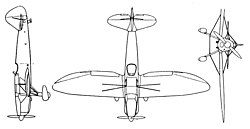| Henschel Hs 125 | |
|---|---|
 | |
| General information | |
| Type | Trainer |
| Designer | |
| Primary user | Luftwaffe |
| Number built | 2 |
| History | |
| First flight | 1934 |
The Henschel Hs 125 was a German advanced training aircraft prototype featuring a single engine and low wing, designed by Henschel & Son and tested by the Luftwaffe in 1934. [1] Only two prototypes were ever built. [2]
